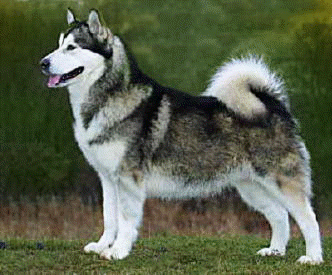|
The Alaskan Malamute, as the name
suggests, originates from Alaska, and was developed for
pulling sleds and drafting. These dogs were also used
for hauling and hunting in larger numbers. These working
dogs were first registered with the AKC in 1935. Perhaps
one of the most undisputed facts about the Alaskan
Malamute is that he is one of the most unaltered breeds
found today. They are descendants of dogs that lives
with the Mahlemut Tribe that was located in upper
portions of western Alaska. These were very distinctive
and necessary animals and often were just as important
to the people in their area. They helped with virtually
all facets of life including hunting and working with
them as well as living with them.
General Appearance
The Alaskan Malamute is a large, strong Arctic dog with
a thick, coarse double coat and a plumed tail held over
the back. It is a ponderous dog, well built, with a
solid body, wide head, and a proud expression. The feet
are furry and have tough pads. It has erect ears and
small, dark, almond shaped eyes. The eyes are obliquely
placed in the skull. Eyes are brown, almond shaped and
of medium size and look like those of a wolf, but with a
sweet expression. Dark eyes are preferred. Blue Eyes are
a Disqualifying Fault. The coat averages one to three
inches in length and comes in white, black & white, wolf
gray, wolf sable (red undercoat with dark gray outer
coat), or red, often with darker highlights and
sometimes with a dark mask or cap. The legs and muzzle
are almost always white. This well built dog has a
beautiful plush tail.
Temperament
The Alaskan Malamute is a dog that may grow into a
dignified, calm adult, but some may continue being
playful and puppy-like even when they are older. This is
a breed that loves to play, and is therefore well suited
to those that enjoy spending time outdoors and enjoying
exercise. It is important to spend time with this breed
and not neglect them, as they can become bored easily
and this can lead to destructive behavior. This is a dog
that loves to play and excise in colder weather, and
their friendly disposition makes them a joy to be
around, although this also means that they are not the
best watchdogs. The breed can be aggressive around same
sex dogs, as well as with other smaller animals. The
Alaskan Malamute is an intelligent and clever dog. They
were bred for many years because of their ability to
haul and work hard, making them a perfect like bred with
this combination. They are dependable and responsible,
also qualities that are good for training.
Grooming
The double coat of the Alaskan Malamute will need to be
brushed around twice a week in order to keep it in good
condition. This breed is a massively heavy shedder. The
undercoat comes out in clumps twice a year. Bathing is
most unnecessary, as the coat sheds dirt readily. Dry
shampoo occasionally. This dog is clean and odorless.
Health Problems and Life Expectancy
The Alaskan Malamute does have some health conditions
that should be paid attention to. For example, they are
known to have hip dysplasia and often have
chrondodysplasia and inherited polyneuropathy (muscle
tone and weakness problems). Another problem that is
often found is that in their eyes. They are prone to
developing cataracts and often have vision problems as
they begin to age. The life expectancy of the Alaskan
Malamute is around 10-12 years. These dogs do not fare
well in warmer climates, and need to be protected from
the heat.
Activity Level
The Alaskan Malamute is a highly energetic animal and
for that reason need to be exercised and played with
often. Since they were raised for use in the workforce,
they are able to devote a lot of attention. They want to
be kept busy. You will want to spend time playing
physical games with this breed. You should also give him
at least a full hours worth of walking per day for
exercise. If you live in a suburban area, a high fence
is a must, but bury the base, because they are likely to
dig their way out. Alaskan Malamutes like to roam in
what he considers to be his territory. The Malamutes
coat allows them to withstand extreme cold, but be
careful to keep the dog cool in hot climates. Make sure
they have shade and plenty of clean cool water.
|







